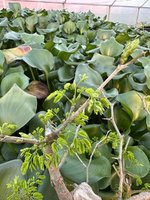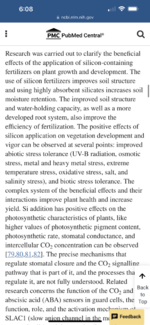The point was that many silicate minerals are not or very poorly water soluble. The point would be about bio availability which would be best with with Calcium or Potassium silicate. Most sand is rich in silicate but would have a low availability of silicate.
Roots exude acids and bases, oxidizers and reductors, as do most biological soil thingies like bacteria and fungi.
If it wouldn't be bio-available, it wouldn't be present already in a whole lot of plant cells.
Quartz being SiO4 with various metal additions, which has the potential to break down to two SiO2 molecules but this is rather rare.
Rare is a very elastic phrasing in molecular science. As in: what sounds rare to us, might not be very "rare" in the actual world when expressed in numbers.
With a rough estimation there are 10000000000000000000000 (1x1^22)molecules of silicon dioxide in a grain of sand. Let's say a grain of sand is only 1% SiO2 and just 1% of that SiO2 becomes bioavailable.
That's a whopping 1000000000000000000 available molecules, eighteen zeroes.
Let's say it's even less rare, let's make it one millionth of a percent. That's still 10000000000 available molecules per grain of sand. Is that ten trillion?
This loops us back to the actual science at hand, because there is a mention of increased resistance-related gene expression. An increase can be measured when the expression exceeds 1x the "normal" expression level. Depending on the definition of normal (are we using a silica devoid control, or something else?), the applied statistics and the sequencing depth, one can detect up to a millionth of an increase and call it significant if we fiddle with what's normal and how we statistically approach it.
Maybe one should look up the composition and bioavailability from our own media like akadama, lava rock, granite, DE..
What I'm saying is that I believe the science behind it, just not the marketing.
The poster of the study, which the guy is co-author of, can be viewed here:
https://digitalcommons.usu.edu/cgi/viewcontent.cgi?article=1008&context=cpl_hydroponics
To me, it shows that the wollastonite is an easy releaser but it stops working just about when rice hulls are picking up the speed. If the soil pH ends up outside the "perfect range -2 or +2 pH points", which for the wollastonite seems to be within.. a week?
Then I'm not sure what to make of this.
If the release over the course of 120 days, which is about my growing season, drops back to regular levels and screws up the pH within days.. Man, I don't know.
Those Rsquared values seem to tell that the data is all over the place and release is anything but linear.
It seems that all positive effects of external application are diminished when plants are already grown in silicium rich media.. Which is basically every bonsai medium out there.
It sounds off to me that stuff like rockwool and perlite (40-80% SiO2) give off so little of it.
Summarized I think that it can be a great addition, but laying too much focus on it as a ferilizer can be dangerous because it can and will fiddle with the pH. If you're using tap water, the soil can become alkaline into the caustic to human skin levels.




